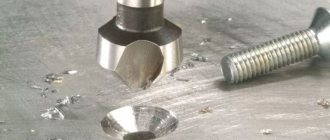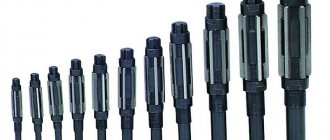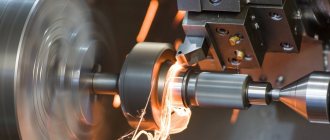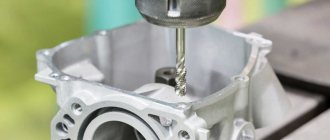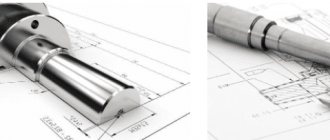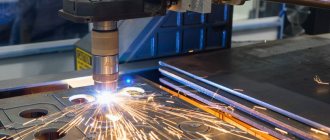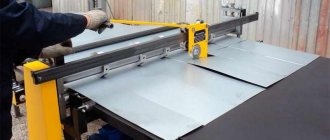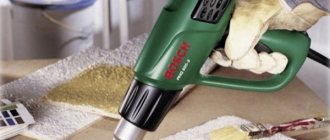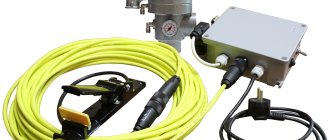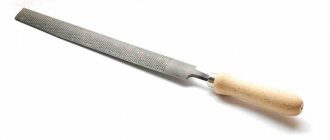Innovation or just another drill?
Every builder knows that it is quite important to properly process a hole before or after using a drill.
After all, the quality of further work depends on this. An assistant in this matter is a countersink - an axial tool with many blades. Many people still confuse it with one of the types of drills. They may look similar in some way, but in reality they are two completely different things. The countersink design is much stronger than the drill design. It also works using a progressive motion and several blades, but, unlike a drill, it removes all the excess from a part or element, and also removes blockages when attaching something to the wall.
Thus, a drill is a cutting tool that allows you to make a hole, and the purpose of a countersink is to process the hole. Countersinks are divided according to parameters such as design and method of fastening. Depending on these factors, they can be tail-mounted or attached, solid or prefabricated. These are the cutting tools that are needed either for preliminary or final processing of holes. In addition to the above parameters, types of countersinks are classified according to the materials used in their manufacture: high-speed steel and hard alloys.
Let's study the countersink a little: the drawings show that it consists of several elements of the cutting part (the main cutting part), the calibrating part (sets the correct direction and calibrates the holes), and the shank (thanks to it the tool can be secured in the machine). But there are options that are mounted differently in the machine. For example, a mounted countersink. He is not quite like the rest of the representatives. The main distinguishing feature is the 4 screw edges, as well as the ability to process parts up to 100 mm.
Photo of a conical countersink for wood, shuruping.ru
In the photo - a set of countersinks, megasklad.ru
Photo of mounted countersinks, tdsvarki.ru
In the photo - a steel countersink with a 6-point shank for wood processing, obi.ru
Photo of a countersink made of Wolfcraft tool steel, megatec.pl
Design features
If we look at the countersink, we can highlight some of its parts
- Cutting part. This is the main part that performs the countersinking process. Consists of several cutting edges located at an angle from the center to the sides.
- Shank. Using a shank, the countersink is secured in the tool or machine in which the work will be performed. The shank can be tapered or cylindrical.
- The part between the shank and the cutting part has a particularly thin shape in one place. This part acts as a fuse. If the countersink gets stuck, in order to avoid serious consequences, it is in this part of the countersink that it breaks.
The structure of a countersink
One of the varieties of a countersink has welded blades on the working part, which makes it possible to process hard metal alloys.
Rules for working with a countersink
When performing work on a lathe or drilling machine with a countersink, you need to remember and follow a number of simple rules. Before starting work, check the condition of the chuck on the machine. After all, if the cartridge is in a faulty condition, it will not be possible to secure the countersink well, and thus you will not be able to get a high-quality machined hole. Countersinking of holes is carried out in accordance with the following rules:
- To perform the work, the countersink must be strictly in the center of the hole being machined.
- When processing hard metals such as cast iron, you need to take breaks from work and use special solutions to remove heat. In everyday life, technical oil is used for such purposes.
- When operating, do not exceed the speed specified by the manufacturer. Failure to comply with this rule will result in rapid wear of the cutting edges due to heating.
- Select the correct countersink diameter for the hole being machined. If you choose the wrong size, the processing will not be of high quality, namely incorrect centering, uneven edges.
Types of countersinks - classify processing methods
Such devices are classified according to the processing method into cylindrical, conical and end-face.
- Cylindrical is used to expand a cylindrical hole by 1-8 mm. If it has a guide pin, then it is needed to process the recesses for the screw heads. These are the tools most often used in industry. It consists of elements that are provided for most of these cutting tools, but there is one difference - the trunnion. It can be solid or removable. Its second option is more convenient for sharpening. After all, it is carried out mainly with the device removed.
- Conical models are needed to process recesses for screw heads, valve seats and other parts. They are straight teeth with a flat surface at the front. Their number can be from 6 to 12. This option, like the cylindrical one, is used for industrial purposes.
- End varieties are used to clean the end planes of bosses and other things. They have teeth only on the end. They can be unilateral or bilateral. The latter have teeth on both sides of the tool.
Countersink
Countersink
Metal processing by countersinking is similar to drilling - this is the rotation of a countersink around its axis. When countersinking, the hole is improved to 9-11 accuracy grades. Also, with the help of a countersink, the roughness of the hole is improved to Rz 2.5 microns.
Main purposes of the countersink:
- Calibration of ready-made holes for fasteners (bolts, studs)
- Improving hole quality before tapping or using a reamer.
Countersinking is not done using a conventional drill or any other manual method. After all, the purpose of this operation is aimed at improving the quality of the hole, which is almost impossible to do with a drill. Therefore, countersinking is performed using a machine tool using drilling, turning, and milling machines.
If we divide countersinks into groups, then in metalworking there are two groups according to accuracy:
- Countersink number 1 - Mainly used for semi-finishing as preparatory work before reaming or cutting threads.
- Countersink with number 2 - Used for final work. Has a relatively high accuracy class H11
According to the design, two types of countersinks are used - solid and mounted (disassembled). If we talk about solid ones, they are used more often, and they have a cone-shaped end. It has a groove for chip removal and cooling and cutting teeth. If we talk about mounted countersinks, their design is distinguished by a removable tip, which is attached through an internal hole.
There are also countersinks that are used much less frequently, in special cases. Namely, these are countersinks with welded plates made of the hardest metal, welded or prefabricated countersinks.
The material from which the countersink tip is made
In solid countersinks, P18 or P19 steel is used to make the cutting teeth. If a countersink is made for processing carbide metals, then its teeth are made of metal-ceramic alloys VK4, VK6 or VK8. If steel products are to be processed - T15K6
How to countersink metal correctly
If an amateur craftsman can take a drill and a drill for countersinking, then in an industrial environment the following machines can be used for this:
- drilling;
- turning;
- boring;
- milling;
- aggregate.
The countersinking process takes place in strict accordance with the technology, the general points of which can be described in the form of the following recommendations:
- In cast parts with an uneven margin for subsequent metalworking, it is necessary to bore the hole to a depth of 5–10 mm for the correct direction of movement of the cutting tool.
- For the countersinking operation, an allowance of 1–3 mm is left, depending on the final diameter.
- Countersinking of steel products is not complete without cooling with special oil solutions. When working with cast iron, as well as non-ferrous metal, it is not mandatory.
- The optimal version of the countersink and the operating mode are selected taking into account the required hole diameter, processing accuracy, its depth, the metal of the part and the options of the production machine.
- The cutting tool mount must fit into the slot that is on the workstation.
- In the case where finishing processing by reaming is expected, then during countersinking a part of the allowance, from 0.15 to 0.3 mm, is left for further work.
- To process products made of hardened and alloyed steels, countersinks with carbide inserts with a diameter of 14-50 mm and 3-4 teeth are used.
- When processing non-ferrous metals and iron alloys with a high carbon content, feather countersinks are used.
- High-speed steel tools are used to process products made from ordinary structural steel. For holes larger than 40 mm, the equipment is supplemented with nozzles with a diameter of 32–80 mm.
The discrepancy between the process and the established technology is often the cause of defects. If the tool wears out a lot, the resulting hole will be smaller than the design. When the master has overestimated the feed, or waste has stuck to the teeth of the countersink, the cleanliness of the processing may not satisfy the quality. Other defects: part of the surface is not processed, the resulting diameter is larger than required, are the result of an incorrect choice of countersink or its incorrect installation.
Operation and repair of metal countersinks
Before you start working, you need to study the safety rules. To protect yourself from injury, you need to:
- Wear a hat, safety glasses, and gloves.
- If work will be carried out on a machine, be sure to install a protective screen made of transparent plastic.
- Wear closed shoes, clothes with tapered sleeves, from which threads and flaps do not stick out.
- Clear the workplace of foreign objects.
- Check the integrity of wires and moving equipment elements.
Do not handle rotating cartridges while wearing gloves.
The countersinking procedure is similar to drilling. After starting the engine, the working part is slowly immersed in a pre-drilled hole. Processing is carried out slowly.
When countersinking, allowances must be observed. It is important to select the diameter of the selected tool so that after processing it matches the size of the hole being processed.
For repairs and sharpening, it is better to contact a workshop. You won’t be able to fix it yourself; this requires professional equipment and practical skills.
DIY countersink
A wood countersink is a fairly popular tool on the market, but your store may not have it, but it is still a necessary thing. And if you already have all the necessary components, then you can build a countersink machine with your own hands. The equipment will be far from the professional units that are used in enterprises and factories, but it has advantages over expensive analogues. In order to build a machine you need the following things:
Powerful drill;
The base of the machine is made of wood or metal;
Sturdy corner tripod, also made of wood or iron;
Homemade stand for extra stability;
Spring mechanism for reverse movement of the drill.
These are the basic components that can be used to assemble a machine that will provide stable and accurate machining. Strength, weight, durability, and construction price will depend on the choice of material. There is no point in saving much in this matter, because countersinking is a precise process, and any deviation or defect can lead to poor results.
To create the attachment itself, use a self-tapping screw or drill, which you need to trim, adding new blades. This design has many advantages:
Created at home from existing components;
Does not require large investments;
Can be customized at any time for individual configurations;
Ability to carry out a variety of types of stationary work with a drill;
But even taking into account all the advantages, the artisanal countersink has a number of disadvantages. Some disadvantages are minor and can be easily corrected, but they exist and are mostly associated with miscalculations during modeling and incorrect assembly of the structure. These are the disadvantages:
An error during sharpening can lead to an overestimated diameter;
Rapid wear of nozzles;
Any defect or error leads to loss of quality;
Therefore, you need to pay attention to calculating the design and testing the machine before its direct use. And if everything is done correctly, then such a machine will be an excellent assistant in working with wooden parts.
And if desired, the equipment can be converted for iron parts.
Video that describes the sequential process of creating a countersink for wood
Terminology
A countersink is a multi-bladed cutting tool used for making holes in metal parts. After processing, conical/cylindrical type recesses are obtained, you can create a reference plane near the holes, and chamfer the center hole.
Countersinking of holes is the secondary preparation of finished holes for placing hardware heads - bolts, screws, rivets
A countersink is a cutting tool with a multi-bladed surface. Used in machining cylindrical/conical holes in workpieces to expand the diameter, improve surface characteristics and accuracy. This type of processing is called countersinking. This is a semi-finish cutting process.
A - drilling with a drill B - boring on a lathe C - countersinking with a countersink D - reaming with a reamer E, F - counterbore with a counterbore G - countersinking with a countersink H - thread cutting with a tap
Countering holes is the process of reworking the top of an opening in order, for example, to remove burrs from the edge of a hole or to create recesses to hide the head of a rivet or screw and level it with the surface of the part. The tool used for this task is called a countersink.
Purpose of countersinking and scope of application
Countersinking holes is a necessary operation in mechanical engineering and machine tool building. Here, the accuracy of the parts must correspond to microns, and this primarily concerns the drilled channels. Holes in metal that do not have a clear cylindrical shape or a strict diameter along the length in critical structures can cause additional play and, as a result, lead to rapid wear of bearing units and destruction of the structure as a whole. Countersinking significantly increases their accuracy, bringing them to the fourth and fifth class.
The process of countersinking in metal workpieces allows you to achieve the following results:
- After processing, the pre-drilled channel acquires a strict cylinder shape along its entire length - this moment facilitates the clear passage of threaded connections, shafts, spindles, rods through it without unnecessary stress and backlash.
- The channel receives strict geometric parameters regarding the diameters at each specific point of the channel. As a result, there is less play and wear of the hole itself, if it is part of the assembly where mechanical transmission occurs, as well as less wear of the transmission mechanism.
- The channel cleanliness is significantly improved. Reduced roughness contributes to less chip formation, which can arise from vibration and friction, greater strength, reliability, wear resistance of the channel and the entire structure as a whole.
If the previously obtained hole has an accuracy class of no higher than third, then it is necessary to carry out countersinking and reaming.
Problems when working with the tool
Like all tools, our subject of discussion can break at the most inopportune moment. This applies not only to the cutting component itself, but also to the element that is used as a power tool. It happens that when using a countersink, the hole turns out to be broken. The reason for this may be an incorrectly sharpened cutting tool. There may be two ways to correct the situation: sharpen it or install a new one.
Another problem that experts face is that part of the hole surface remains untreated. There may be two reasons: the cutter allowance is too small, this can be corrected by increasing the allowance, or the workpiece in the chuck is skewed, here you need to carefully inspect the workpiece and check the hole for runout. The most common problem is inadequate quality of the treated surface. There can be 4 reasons for this situation: a large allowance (eliminate by reducing it), a dull tool (replace it with another), chips on the ribbons (clean the cutting tool from chips more often), too much feed (reduce it).
These are the main problems encountered when working with a countersink. But there are also related situations that can be avoided with proper operation of the device. Therefore, you should first study the instructions that come with it. After all, it is there that you can find answers to most questions regarding operation. Thus, the described tool can process both parts and surfaces. The main specialists who use it are turners, finishers and those whose professions are directly related to the processing of parts.
Basic rules for countersinking processing
Correct countersinking processing requires adherence to a specific technological process, which is developed for a specific part. The technological process itself is built on principles or rules that take into account absolutely any initial conditions: type of metal, hole diameter, shape, configuration, channel length, final countersinking task, type of tool.
The basic rules for processing with a countersink are as follows:
- After casting, stamping or drilling process, the allowance on the side in the hole for countersinking should be 0.5–3 millimeters.
- The type of cutting element must match the type of hole. They can be through, stepped or blind.
- The rotation speed when processing a cutter made of high-speed steel should not differ from the rotation speed of a conventional metal drill.
- The rotation speed of a cutter with carbide cutting edges can be increased two or three times compared to the rotation speed of a conventional countersink.
- For high precision machining of holes produced by casting or stamping, having a deep channel, they are first passed with a cutter to the depth of half the working fluid of the countersink and with a diameter equal to the diameter of the cutting edge.
When using countersinks made of high-speed steel, a substance is supplied into the channel being processed for lubrication and cooling.
General rules for selecting countersinks and equipment
Before choosing, you need to decide what needs to be obtained after such processing - to improve the quality of the hole, or to increase its dimensional accuracy. The first option is necessary if a thread needs to be cut in the hole (especially with a fine pitch), and the second option is necessary if calibrated fasteners in the form of screws, pins, etc. will be inserted into the hole.
Taking into account the profile of the working end of the countersink described above, it can also be used to process surfaces directly adjacent to the hole, for example, in order to obtain a hole for a countersunk hole.
Depending on the working conditions, a distinction is made between solid steel countersinks and tools with carbide nozzles. In the first case, high-speed steels of type R6M5 or R6M5K5 are used for manufacturing (working with steel workpieces), in the second - for work on wood - countersinks made of ordinary carbon steel of type U7 or U8 can also be used.
Carbide mounted countersinks are made from metal ceramics of the VK4, VK3M brands, mineral ceramics TsM-332, as well as from tungsten-free hard alloys TM-1 or TM-20. Such plate-shaped nozzles are soldered to the steel body with copper. The advantages of carbide attachments for countersinks are the ability to use high-speed cutting modes during processing.
The durability of a countersink is determined by the mode of its heat treatment, and, accordingly, by its hardness. The working part of a tool made of high-speed steel must be at least HRC 62...64, and the shank must be within HRC 35...45. Countersinks made of carbon tool steels have a hardness of the working part of HRC 56...60. When purchasing, it is advisable to check countersinks for metal with small diameters (up to 6 mm) for hardness using a calibrated file.
For wood countersinks, prefabricated and solid structures are also used. This production technology is less labor-intensive, however, prefabricated welded versions of the tool are very sensitive to radial, and especially axial, runout, so the technical condition of the machine tool or drill chuck should be checked more carefully.
When selecting the standard size of a countersink, it is necessary to take into account not only the size range of the holes being machined, in particular their depth, but also the actual power of the equipment used. The fact is that countersinking is a more energy-intensive operation compared to drilling. It requires increased drive power, since it is always produced with significant power loads on the tool. Therefore, the choice, in particular, of a drill is determined not only by the possibility of its operation at low speeds, but also by sufficient engine power (at least 1.6 kW).
However, it should be remembered that countersinking, which is performed on a machine, is considered to be of the highest quality. Drilling, turning, and boring machines are successfully used here. A milling machine can also be used for processing, but only if it has a CNC device.
Home craftsmen usually purchase countersinks in a set. This is convenient and profitable, but you should check the possibility of installing the shank in the chuck of the main equipment.
https://youtube.com/watch?v=5urK7WQeNRE%3F
Features of countersinking holes
Countersinking holes is a high-precision operation that requires high-quality tools and proper drilling equipment. Countersinks must undergo periodic inspection to ensure compliance with the standard for diameter and taper angle. The test results are recorded in the instrumental section log.
Metalworking specialists have formulated the following recommendations for performing the operation:
- when working with hard steel or cast iron alloys, special emulsions, for example, coolant liquid, should be used to cool the material and tool;
- when selecting a tool, you need to take into account the material of the part, its strength and hardness;
- Before starting work, you should check the reliability and accuracy of fixation of the tool in the chuck and the absence of any special spindle runout;
- to countersink an internal chamfer, you should use a special mandrel that centers the tool;
The countersunk hole should be checked for compliance with the dimensions of the drawing only with a verified measuring tool.
Features of countersinking
This procedure is similar to drilling, because it is also performed with a hole already made. The only difference is that countersinking is characterized by the highest accuracy. At the same time, various kinds of shortcomings and defects that appear during drilling, casting or stamping are eliminated. In addition, indicators such as accuracy and surface finish are improved, and a high level of alignment is obtained.
It often happens that when creating a hole with a drill, there is a deviation from the center point. This is due to insufficient rigidity of the cutting tool. A countersink is characterized by greater rigidity than an ordinary drill, since it has more teeth.
A more high-precision operation is considered to be reaming, which is already a finishing processing process.
Countersinking is often confused with countersinking, for which a completely different device is provided - a countersink. This tool has a different design and is intended for other technological operations.
A countersink is used to remove chamfers from holes, as well as to create conical recesses. There are also cylindrical countersinks, but these devices are called counterbores.
https://youtube.com/watch?v=f_A28_RQTSM
Countersink. Purpose and types of tools
A countersink is a tool designed for semi-finishing metal. Externally, it is a metal shaft with cutting surfaces, reminiscent of a drill. It is created specifically for the metalworking industry. Produced in accordance with GOST 12489-71, GOST 3231-71 or TU 2-035-923-83 in accordance with the type of device.
Countersinks are divided into:
By type of fastening in the machine chuck:
- tail;
- mounted
By design features:
- solid;
- prefabricated;
- welded;
- with and without carbide inserts.
By geometric shape:
- cylindrical;
- conical;
- reverse.
In the direction of the ribbons and grooves:
- right rotation;
- left rotation.
Solid shank countersinks are most similar to drills, but differ in the presence of more cutting edges. In their cross section there are from 3 to 6 such sharp teeth. For production, high-speed tool steels R9, R18 are used, as well as alloy plates with increased hardness and wear resistance VK4, VK6, VK8, T15K6. The permissible cutting speed for models with carbide inserts is higher, which increases their efficiency.
There are strictly 4 teeth in diameter. The nozzle itself is sometimes equipped with removable working blades made of hard alloys. The cutters are fixed with wedges and can be replaced as needed.
A conical countersink is similar to a drill; the working part of the tool tapers towards its end. Used for processing inclined circular surfaces. Manufactured from alloy steel and metal-ceramics.
The ribbons of the countersink drill can be twisted in different directions; accordingly, the profiles of right and left rotation are distinguished. Left-hand rotation countersinks are used in semi-automatic lathes that feed material from the right side.
The choice of type of countersink is directly determined by the size of the hole in the workpiece and its material. With a diameter of up to 12 mm, they work with solid countersinks, starting from 20 mm - with countersink attachments and tools with inserted alloy blades. When it is necessary to make smoother and larger holes, combined models are installed in the machine, where there can be up to eight sharp teeth, and these countersinks are optionally combined with drills, reamers and other drilling and cutting tools.
Types and purpose of countersinks
A countersink drill is used for countersinking. Despite the fact that this operation, like countersinking, is aimed at processing holes in workpieces made of various materials, their final purpose will be different. This operation is required in cases where there is a need to create cylindrical or conical recesses to hide the heads of fasteners.
Processing of workpieces with a countersink refers to semi-finishing, and is performed before deployment. Countersinking is carried out on turning, milling, boring, drilling machines at low speeds.
According to their design, countersinks are divided into two types:
- Conical.
- Cylindrical.
A separate group consists of carbide countersinks (cones), the main purpose of which is grinding and roughing work. To process holes and chamfer in hard-to-reach places, another type of tool is used - a reverse countersink. To ensure the implementation of any goals for metal and wood processing, it is more advisable to purchase a set of countersinks rather than individual tools.
The design of conical countersinks includes a shank and a working part with a cone angle at the apex of 60°, 75°, 90°, 120°. The number of cutting teeth of the working part differs depending on the diameter of the device (12–60 mm), and can be from 6 to 12. To ensure the alignment of the hole being processed, a pin is used.
A cylindrical countersink can have a wear-resistant coating. This device is used for cutting chamfers for hardware. In its design, it is similar to a drill, but has a larger number of cutting elements - from four to ten, depending on the diameter of the tool. At the end of the working part there is a guide pin, with the help of which the position of the tool is fixed during operation. The trunnion can be removable or solid. Devices with removable pins are more often used, as they are more practical. A cutting attachment can also be installed on the countersink.
To machine several holes to the same depth, countersinks are used with holders that have rotating and stationary stops. When processing a workpiece, the cutting tool is mounted in a holder and protrudes from its stop at a distance equal to the depth of the holes.
Countersinks are made from alloyed tool, high-speed, carbon, and carbide steels. Carbide tools can withstand heavy loads over long periods of time. They are usually used for processing metal workpieces. Countersinks for wood and non-ferrous metals are made of high-speed steels, since the tool is subjected to significantly less load during operation. At high loads, for example when processing cast iron workpieces, tool cooling is required using special emulsions.
Design
The conical countersink has two main structural parts:
- a shank designed for attaching a countersink to the chuck of a drilling or lathe;
- a working body for countersinking holes, consisting of 6 ÷ 12 cutting edges of increased thickness (compared to a drill.
The cone sweep angle is from 60 to 120°. The number of edges depends on the diameter of the tool; the larger it is, the more edges there are.
A cylindrical countersink is structurally similar to a drill, but has a larger number of cutting edges. Their length, unlike a drill, is limited by the diameter of the cylinder, since the countersink makes only small recesses in depth.
At the end there is a guide pin that ensures fastening in the chuck. A removable belt can be installed behind the ends of the cutting edges, limiting the depth of immersion into the workpiece. The limiter can be designed as a non-removable part of the countersink. If necessary, a cutting attachment is mounted on the countersink. When depicting a hole in a drawing, the type and size of the countersink is indicated next to it or in an explanatory note in the margin.
For the manufacture of countersinks, high-quality steels are used: tool, high-speed, carbon. The tool is subjected to multi-stage heat treatment, which improves its strength properties.
